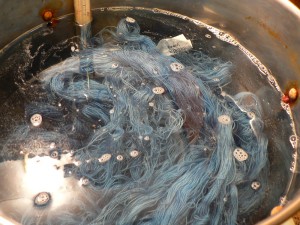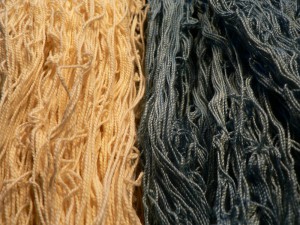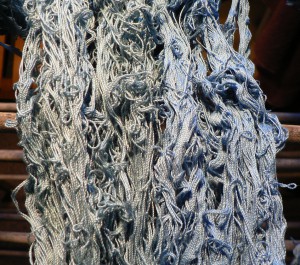After those intense, vivid colors on 40/2 linen yarns from the first and second weld exhaust baths, I assumed there was still quite a bit of color left in the bath. I thought it would be fun to try a couple experiments. My first experiment was to put a mordanted cotton-linen blend skein in the weld bath overnight, but not to heat it at all.
Why would I even try this? Well, the answer is kind of a long story. Even though my usual method is to apply heat when extracting color and dyeing fiber, I am very aware of the fact that this requires energy. Way back in 2006 I was lucky enough to get the opportunity to travel to Kyrgyzstan along with feltmaker Karen Page, to work with a group of women in a village who wanted to develop a crafts business. My part of the project was to teach them what I knew about natural dyeing, and Karen’s job was to teach them new felting techniques.
For the dyeing part of the workshop we used firewood to heat the water for the dyebaths. Specifically, our wood was small branches and twigs. Kyrgyzstan is an arid, high altitude, Central Asian country where most of the water comes from run-off from the snow-capped Tien Shan mountains. For various reasons, including climate but also deforestation due to logging and sheep-grazing during the Soviet period, there are not a lot of trees. In our village setting, many people used dried dung as a fuel (common around the world, actually), and wood was a precious commodity. There was limited running water in the village, which flowed down from a stream that ran uphill above the village, but this water was carefully allotted to each neighborhood on a schedule. Our workshop participants had unsuccessfully petitioned their village government to give us a greater water allotment for the duration of our workshop, but since their request was turned down, we had to carry water from a well in a participant’s back yard. It was a couple yards over, not that far away, but still required some effort to carry to the community center where we were working. Water was also a precious commodity. Why would you waste water and fuel on something speculative (it might result in something that might make money sometime) and inessential?
So, this experience made me acutely aware of the fact that my methods are very “first world” and that I ought to do more to conserve limited resources. I resolved to learn more about dyeing without fuel inputs, e.g., solar dyeing, but I have sadly not made much progress in that regard. Partly I blame the fact that I live in New England where water is plentiful and sun and heat are comparatively scarce. For many months of the year I cannot work outside at all, so solar dyeing is a seasonal activity. Partly I blame the fact that I squeeze dyeing in around the other things in my life (e.g., work) and cold-soaking is slow. The quickest way to do it is usually the most practical for me. Partly I just haven’t prioritized it. I have tried occasional experiments in cold-soaking, though, and have been pretty pleased with the results. So I decided to try a cold-soak in this case.
OK, back to the main story. The skein sat in the weld exhaust overnight. In the morning it was pretty light, but I figured that was because I hadn’t applied any heat. Since the color pretty much matched my expectations, I took it out, didn’t really question it, and went on to experiment number two.
Experiment number two was to overdye some woad-dyed 10/2 cotton skeins. Woad will bond to fiber without a mordant, though I sometimes mordant fiber for a woad bath anyway because I think it results in deeper color. This is a hypothesis that I have not rigorously tested, however, and certainly bears further investigation. In this case the woad-dyed skeins were not mordanted. So, I mordanted them with aluminum sulfate at about 5% WOG (weight of the goods, i.e., the yarn) and soda ash at about 3%.
Here are some of the woad-dyed yarns in the mordant bath.
Here are two of the woad skeins in the weld exhaust bath:
You can see that the bath still has some yellow left in it, but it is not sticking to the yarn.
Here are the yarns after they were washed and dried. On the left is the cold-soaked weld skein. On the right is one of the skeins that I tried to dye green, but as you can see it is not green. The exposure is a little dark, the relative colors are pretty accurate.
Here is one of the not-green skeins on the left next to a mordanted woad-dyed skein on the right. This photo is a little over-exposed, but again the relative colors are pretty accurate.
I have never managed to get a good green on cellulose yarn using weld and woad, and this time was no exception. I have managed, in the past, to get a nice greenish blue on cotton cloth with weld and woad (weld first, overdyed with woad) but I can’t explain why the fabric sample was more successful. In the past I have always tried overdye blue on top of yellow. I suspect that the not-green skein above is a much lighter blue than the mordanted yarn because the alkalinity of the weld exhaust bath dissolved some of the woad back into solution and it washed off when I rinsed the skein. I also suspect that the exhaust bath was basically done and didn’t have much color left.
Experiments to try this summer:
1. Weld-yellow first, on mordanted yarn, then woad on top is more likely to yield green on cellulose yarn. I don’t think the pH of the weld bath would matter in this process because the subsequent woad vat would also have high pH.
2. A natural fermentation vat might give better greens because the color-remover which I use as a reducing agent may be pulling off the weld-yellow from the cellulose fiber.
3. Try woad first, then mordanting, then weld, but use a full-strength dyebath next time.
4. If trying woad first, then mordanting, then weld, do not shift the weld bath to a high pH. This one bothers me a bit because I don’t know how the yellow will develop without a high pH, but clearly having a high pH doesn’t help the blue.
5. Hypothesis: Weld and woad on cellulose are a lost cause and I should try a different source of yellow on cellulose if i want to get a good green. The reason I’m reluctant to accept this hypothesis is that I have read that weld and woad were used in combination, historically, to make consistent and successful greens. But maybe this was only on wool. I have never had a problem getting nice greens on wool with any source of yellow plus woad. The difficulty is just with cellulose fibers.




